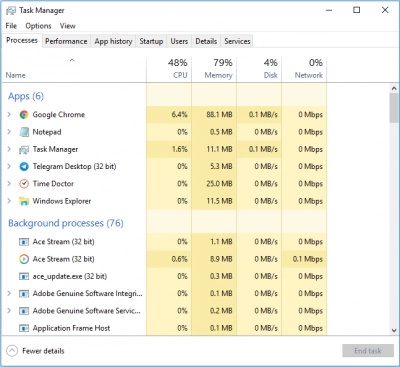How to interact with Searchui.exe?
Here you will find out:
- how to interact with Searchui.exe
- how DiskInternals Partition Recovery can help you
Are you ready? Let's read!
About searchui.exe
The Cortana utility in Windows OS is the process of searching for data in the file system. In turn, it is displayed as SearchUI.exe in the device manager. You should not completely equate these concepts since the Cortana process is a larger tool and represents a broader search concept. Therefore, you need to be able to distinguish between these two processes, although they are very similar.
In order to find out if the process is running, you need to open the Task Manager. This will display the Cortana process listed. Right-click on the Cortana process and go to Details, a process named SearchUI.exe will be displayed. To search for the localization of SearchUI.exe in the system directory, right-click on the specified process and click on Open file location.

The file is part of Microsoft.Windows.Cortana_cw5n1h2txyewy software. Such an application looks like Cortana in the directory of running processes. Thus, the process is identified as Cortana to facilitate understanding of the processes. You can end the SearchUI.exe process for a better understanding. Open the Task Manager menu on your computer and select the Cortana process. Disable the process.
Then rename the Microsoft.Windows.Cortana_cw5n1h2txyewy folder to any other name. The utility will stop running in the background.
Along with this, the ability to search in the OS will also be disabled. To check this, press the key combination Windows + S or click on the Search line in Windows. No action will follow. To return everything to its original name, return the Cortana folder to its true name, and now the function will resume working. The Cortana Utility is Microsoft's online helper tool and is the real name of all search engines in Windows 10.
If you disable the Cortana process, the OS will not be able to search online. However, the search processes on the computer will continue to work. Local search engines are part of the Cortana utility. With Cortana, the Microsoft campaign can run in Windows. Now, you understand that SearchUI.exe and Cortana are closely related, but nevertheless, they are not the same process.
How to interact with it?
The SearchUI.exe process, or Cortana more generally, does not use a lot of CPU. The utilities usually don't work until you open them at will. It is known that the Cortana function or SearchUI.exe actually uses an insignificant amount of memory, 37.4 MB, and does not use the processor at all. As soon as you open the Search in Windows line in the Taskbar menu or hold down the Windows + S hotkeys, memory starts to be consumed from the launched Cortana process. And the process of memory consumption itself will last as long as the Search window is open.
Normally, the utility does not use more memory than previously indicated and only during the startup and operation of the process. Also, you should be aware that Cortana does not handle indexing data. The operating system usually indexes the data by taking into account the text within each of them. This allows you to specifically find the requested files in the Windows search engine.
While indexing files, you can open the Task Manager menu. The processes running during indexing include "Microsoft Windows Search Indexer", "Microsoft Windows Search Filter Host", and "Microsoft Windows Search Protocol Host." You can influence the indexing process.
Click the Start icon on the taskbar and open Indexing Options. With this function, you can select the localization in the system directory in which the OS indexes the data and cancel the data that you do not want to index.
Even with any cautious handling of files, any user - be it a professional or a regular user - may experience loss or damage to data
Many hours of work with a file that will then be damaged will cause tremendous stress for the user. Of course, you can make copies of valuable data on other storage media.
However, you must admit that it is not always possible to do this, especially when damage occurs during work. There are many reasons for this. If they are grouped, the following reasons can be distinguished:
- Accidental deletion of files. Paradoxically, any user, by accidentally pressing a key combination, can part with valuable files.
- A sudden power surge can mechanically damage both internal and external storage media.
- Virus and malware attack from the Network or connected unverified external drives.
Therefore, it is vital to have a program to recover deleted or damaged data with you. The most efficient and easy-to-use program at the moment is DiskInternals Partition Recovery. It works with many file systems, such as FAT, ReFS, UFS, HFS, NTFS, ReiserFS, APFS (reader mode), RomFS (reader mode), Reiser4, XFS, Ext2, Ext3, and Ext4. There is a recovery wizard built into the program to make restoring process easier. The recovery process itself will seem comfortable and intuitive to you since the built-in recovery wizard will help you at all stages.
The program has three scanning modes to choose from - fast scanning, full scanning, and reader mode depending on your preference and time availability. So, in order to complete the process of recovering deleted files, follow the step-by-step instructions. Download and run the trial version of DiskInternals Partition Recovery. In parallel with the launch, the recovery wizard will open. Next, select the drive where you want to search and restore.
Select the file system scan mode. Wait for the scan to finish and view the files available for recovery in the preview tool. If you are convinced of the program's capabilities, buy a license on the official website and save the files on any data carrier. With DiskInternals Partition Recovery, you can no longer worry about the safety of files on your computer. A few clicks are enough, and the program will do everything quickly for you.
